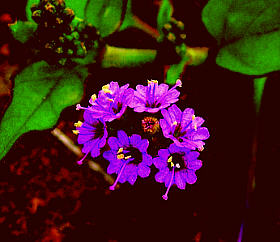|
Liver, gallbladder, and kidney disorders
Erva Tostao
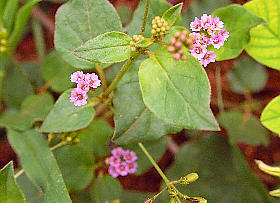
Erva Tostao
(Boerhaavia diffusa)
Code: BOS235 -- Price: $18.50
120 Capsules x 500 mg.
Order Now
 Email
Email
 Summarized Description: Summarized Description:
Erva Tostao, also known by its genus name, "Boerhavia," is a member of the
Four O'Clock family,
with very wide geographic distribution. This has probably contributed to its
confused taxonomy: B. diffusa, B. hirsuta, B. repens, all refer to the very
same plant, and there's a half dozen other species names for it, as well.
It has too many common names to list then all herein.
Uses & Protocols
 The most common herbal application of Erva,
and this is true in Africa and South American herbal traditions as well as ayurveda,
is in the treatment of liver problems, including jaundice and hepatitis;
gallbladder pains / stones; and to expel worms. However, its range of
medicinal activity that the properties and indications below should be
carefully reviewed.
 Dosage: Dosage: Two capsules, twice a day, or as
otherwise directed by your health care practitioner.
Warnings & Contraindications
 Do not take Erva if you're on hypotensive,
cardiodepressant, or barbituate drugs. Those with heart problems stemming from low
blood pressure or heart failure should similarly not take this herb. Erva may interfere
with prescription diuretics and can potentiate cardiac depressant medications, prescription
diuretics, alpha-adrenergic, and ACE-inhibitor medications for high blood pressure.
Shelf-Life
 Five years or more.
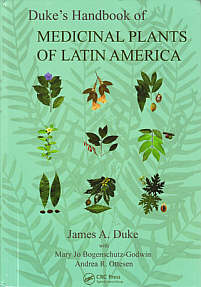
Medicinal Activities
 Further information for practitioners: Further information for practitioners:
World-famous botanist Dr. James Duke attributes the following activities
to this plant (p. 112-116; see hardcopy cover at right,
purchasable on Amazon),
drawn from the extant literature. (See his graduation for "level of
efficacy" on our amazon traditionals page;
followed by Duke's bibliographic abbreviations (in capital letters),
which we identify
on a separate page.)
Indications
 Further information for practitioners: Further information for practitioners:
Duke provides the following indications for this plant:
- Abortifacient (f; ADP; RAI)
- ACE-Inhibitor (1; RAI)
- Adaptogenic (f; RAI)
- Alexiteric (f; KAB; SKJ)
- Amebicide (f1; RAI)
- Analgesic (f1; RAI; WO3)
- Anthelmintic (f1; DEP; KAP; RAI)
- Antibilious (f; DAV)
- Anticancer (1; X15266960)
- Anticancer, skin (f; X15670614)
- Anticancer, lung (1; X15670614)
- Anticonvulsant (f1; RAI; WO2)
- Antidiabetic (1; X15036478; X15511002; X15671692)
- Antidiuretic (f1; RAI)
- Antiedemic (f1; KAP; MPI; WO2)
- Antifibrinolytic (1; RAI; WO3)
- Antihyperlipidemic (1; X15671692)
- Antiinflammatory (f1; RAI; WO2; WO3)
- Antimelanomic (1; X15670614)
- Antimetastatic (1; X15670614)
- Antioxidant (1; X15587591)
- Antiperoxidant (1; X15587591)
- Antiproliferant (1; RAI; X15670614)
- Antiseptic (1; RAI; X16281821)
- Antispasmodic (f1; AHL; RAI; X16254824; X16792408)
- Antitumor (1; X15266960)
- Antiviral (f1; RAI; WO2; X3094284)
- Aphrodisiac (f; RAI)
- Bactericide (f1; RAI; WO2)
- Calcium-Antagonist (1; RAI; X1934177)
- Cardiodepressant (1; RAI)
- Cardiotonic (f1; KAP; MPI;WO2)
- Carminative (f; NPM)
- Chemopreventive (1; X15266960)
- Cholagogue (f; RAI)
- Choleretic (f1; RAI; X2056758)
- Contraceptive (f; ADP)
- Cortisolytic (1; X15587591)
- Depurative (f1; AHL; RAI)
- Detoxicant (f1; RAI)
- Diaphoretic (f; MPI)
- Diuretic (f1; DAV; EGG; KAP; NAD; RAI)
- Emetic (f; EGG; NAD; RAI)
- Emmenagogue (f; RAI)
- Expectorant (f; KAP; RAI; WO2)
- Febrifuge (f; KAP; RAI)
- Fungicide (1; X15847339; X16281821)
- Hematinic (1; WO2)
- Hemostat (f1; JTR; RAI)
- Hepatoprotective (f1; RAI; WO3; X2056758; X9147255)
- Hepatotonic (f1; RAI)
- Hyperglycemic (1; X15587591)
- Hypotensive (f1; RAI)
- Hypouricemic (1; WO2)
- Immunomodulatory (1; RAI)
- Immunosuppressant (1; X15683850)
- Lactagogue (f1; DEP; RAI)
- Laxative (f1; RAI)
- MMP-2-Inhibitor (1; X15670614)
- MMP-9-Inhibitor (1; X15670614)
- Myodepressant (f; RAI)
- Negative-Chronotropic (1; WO2)
- Ophtalmic (f; RAI)
- Orexigenic (f; ADP; RAI)
- Parasiticide (f; RAI)
- Purgative (f; KAP)
- Stimulant (f; JFM)
- Stomachic (f; NPM; RAI)
- Sudorific (f; JFM)
- Tonic (f; JFM; RAI)
- Vermifuge (f1; JFM; RAI)
Indications
 Further information for practitioners: Further information for practitioners:
Duke provides the following indications for this plant:
- Abscesses (f; DEP; RAI)
- Albuminuria (f; AHL; RAI)
- Alcoholism (f; NAD)
- Amebiasis (f1; RAI)
- Amenorrhea (f; RAI)
- Anasarca (f; KAP; SKJ)
- Anemia (f; KAP; RAI; SKJ)
- Anorexia (f; RAI)
- Arthrosis (f1; KAP; MPI; RAI)
- Ascites (f1; NAD; RAI; WO2)
- Asthma (f; AHL; KAP; RAI)
- Bacillus (1; RAI)
- Backache (f; NPM)
- Bacteria (f1; RAI)
- Beri Beri (f; RAI)
- Biliousness (f; NAD; NPM)
- Bleeding (f1; ADP; JFM; RAI)
- Blennorrhagia (f; RAI)
- Blepharosis (f; NAD)
- Boils (f; ADP; RAI)
- Bright's disease (f; KAB)
- Bronchosis (f; DEP)
- Calculi (f; RAI)
- Cancer (f1; ADP; KAB; RAI; X15266960)
- Cancer, abdomen (f; ADP; RAI; SKJ)
- Cancer, intestine (f1; WO2)
- Cancer, skin (f1; RAI; X15266960)
- Cardiopathy (f; RAI; SKJ)
- Cataracts (f; RAI)
- Childbirth (f; ADP; RAI; WO2)
- Cholecocystosis (f; DAV; EGG)
- Cholera (f; RAI)
- Cirrhosis (f1; NAD; WO2)
- Colic (f; NAD)
- Constipation (f; KAP; RAI)
- Convulsions (f1; RAI)
- Coughs (f; NAD; RAI)
- Cramps (f1; X16254824)
- Cystosis (f; RAI)
- Debility (f; DEP; RAI)
- Dermatophyte (1; X15847339)
- Dermatosis (f; ADP)
- Diabetes (1; X15671692)
- Diarrhea (f; AHL)
- Dropsy (f; ADP; AHL; RAI; SKJ)
- Dysentery (f; NAD)
- Dysmenorrhea (f; RAI)
- Dyspepsia (f; KAB; RAI)
- Dyspnea (f; NAD)
- Dysuria (f; NPM; RAI)
- Eczema (f; ADP)
- Edema (f1; RAI; WO2)
- Enterosis (f; RAI; WO2; X16792408)
- Epilepsy (f; AHL)
- Erysipelas (f; AHL; DAW; RAI)
- Fever (f; NPM; RAI)
- Fracture (f; JFM)
- Fungus (1; X15847339; X16281821)
- Gallstones (f; RAI)
- Gas (f; NPM; RAI) NMP
- Gastrosis (f; NPM; X16792408)
- Gonorrhea (f1; ADP; RAI; SKJ)
- Gout (f1; NAD; WO2)
- Guinea Worm (f; RAI; SKJ)
- Headache (f; NPM)
- Hemorrhage (f; RAI)
- Hemorrhoids (f; ADP; RAI)
- Hepatosis (f1; DAV; EGG; RAI)
- High Blood Pressure (f1; RAI)
- Hives (f; RAI)
- Hysteria (f; AHL)
- Infection (f1; RAI; X15847339)
- Inflammation (f1; KAP; RAI; WO2)
- Itch (f; ADP; KAB)
- Jaundice (f; ADP; AHL; NPM; RAI)
- Keratitis (f; WO3)
- Kidney Stones (f; NAD)
- Leprosy (f; NAD)
- Leukorrhea (f; NPM)
- Lumbago (f; RAI; SKJ)
- Malaria (f; AHL)
- Melanoma (1; X15670614)
- Metastasis (1; X15670614)
- Myalgia (f; ADP; WO2)
- Mycosis (1; X15847339; X16281821)
- Nephrosis (f12; RAI; WO3)
- Neuralgia (f; JFM)
- Neurosis (f; AHL)
- Nyctalopia (f; KAP)
- Obesity (1; X15671692)
- Oliguria (f1; ADP; AHL)
- Ophthalmia (f; ADP; RAI; WO2)
- Pain (f1; RAI; WO2; WO3)
- Paralysis (f; JFM)
- Parasites (f; RAI)
- Peritonitis (f1; NAD; WO2)
- Phthisis (f; NAD)
- Pseudomonas (1; RAI)
- Rheumatism (f; ADP; RAI)
- Salmonella (1; RAI)
- Scabies (f; KAB; SKJ)
- Snake Bite (f; KAB; KAP; RAI; SKJ)
- Spasms (f1; AHL; X16254824; X16792408)
- Splenosis (f; KAB)
- Staphylococcus (1; RAI)
- Sterility (f; RAI)
- Stones (f; NAD; RAI)
- Stress (1; RAI)
- Swelling (f; DEP)
- Urethritis (f; NAD; NPM)
- Urticaria (f; RAI)
- Uterosis (f; JFM)
- VD (f; RAI)
- Viruses (1; RAI; X3094284)
- Weakness (f; RAI)
- Worms (f; NAD)
- Yaws (f; RAI)
|
 To U.S. Users: To U.S. Users: This product
have not been evaluated by the U.S. Food & Drug Administration.
It is not intended to diagnose, treat, cure, or prevent any disease.
|
 Recent Studies on Erva
Recent Studies on Erva
Sourced from PubMed
 Disclaimer: The following citations provide findings on the
properties of Erva and offer insights into prospective areas of future research.
These findings should not be inferred to provide the basis of medicinal claims,
nor should they be relied upon by the public, as such. Readers who want full access to
the PubMed database are encouraged to
register with NCBI. Disclaimer: The following citations provide findings on the
properties of Erva and offer insights into prospective areas of future research.
These findings should not be inferred to provide the basis of medicinal claims,
nor should they be relied upon by the public, as such. Readers who want full access to
the PubMed database are encouraged to
register with NCBI.
 As of Jan. 2017, there were
256 citations on PubMed for Erva. Below we list a few of the more notable: As of Jan. 2017, there were
256 citations on PubMed for Erva. Below we list a few of the more notable:
-
Ethnomedicinal uses, phytochemistry and pharmacological properties of the genus Boerhavia. (2016)
-
Antileishmanial efficacy of Boerhaavia diffusa L. and Ocimum sanctum L. against experimental visceral leishmaniasis. (2015)
[ABSTRACT: The chemotherapy of visceral leishmaniasis (VL) has several limitations including resistance and toxicity of the existing
drugs. Down regulation of immune system further aggravates the problems. To combat this situation we evaluated the leishmanicidal efficacy of
Boerhaavia diffusa and Ocimum sanctum through oral route in L. donovani infection in BALB/c mice. Results have demonstrated maximum clearance
of the parasites from infected animals treated with combination of B. diffusa and O. sanctum (@ 100 and 400 mg/kg body wt., respectively 5 days)
as depicted through Leishman Donovan Units in liver. Up-regulation of cell-mediated immunity was also observed in animals of this group as
heightened delayed type hypersensitivity responses and increased IgG2a levels were observed. Moreover, increased levels of SGOT, SGPT, serum urea,
blood urea nitrogen and serum creatinine were brought down to normal levels. Since VL is associated immunosuppression, the above treatment is a
good option as it helps in the up-regulation of Th1 responses and reduction in parasite load in L. donovani infected mice. These findings suggest
a new option for antileishmanial chemotherapy at lower cost and nil toxicity.]
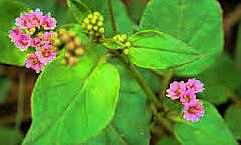
-
Advances in Boerhaavia diffusa hairy root technology: a valuable pursuit for identifying strain sensitivity
and up-scaling factors to refine metabolite yield and bioactivity potentials. (2016)
-
Attenuation of Oxidative Damage by Boerhaavia diffusa L. Against Different Neurotoxic Agents in
Rat Brain Homogenate. (2016)
-
Efficient micropropagation and assessment of genetic fidelity of Boerhaavia diffusa L- High trade medicinal plant. (2015)
-
Evaluation of the effect of Boerhavia diffusa on gentamicin-induced nephrotoxicity in rats. (2015)
[CONCLUSION: B. diffusa exerted protection against structural and functional damage induced by gentamicin
possibly due to its antioxidant properties.]
-
Protective effect of Boerhaavia diffusa L. against mitochondrial dysfunction in angiotensin II induced hypertrophy in H9c2 cardiomyoblast cells.
(2014)
-
Evidence for involvement of the monoaminergic system in antidepressant-like activity of an ethanol extract of Boerhaavia diffusa and its
isolated constituent, punarnavine, in mice. (2014)
-
Punarnavine, an alkaloid from Boerhaavia diffusa exhibits anti-angiogenic activity via downregulation of VEGF in vitro and in vivo. (2013)
-
Effect of Boerhaavia diffusa in experimental prostatic hyperplasia in rats. (2013)
[CONCLUSION: The results suggested that treatment with B. diffusa may improve symptoms of disease and inhibit the increased prostate size.
In vitro study implies that herbal extracts has the machinery to produce beneficial effect on prostatic smooth muscle,
which would relieve the urinary symptoms of disease. B. diffusa could be a potential source of new treatment of prostatic hyperplasia.]
-
Phytochemical screening and in vitro bioactivities of the extracts of aerial part of Boerhavia diffusa Linn. (2012)
[CONCLUSION:] The present findings suggest that (this plant) could be a prominent source of
medicinally important natural compounds.
-
Inhibition of Human Cervical Cancer Cell Growth by Ethanolic Extract of Boerhaavia diffusa Linn. (Punarnava) Root. (2011)
[ABSTRACT:
In Indian traditional medicine, Boerhaavia diffusa (punarnava) roots have been widely used for the treatment of dyspepsia, jaundice,
enlargement of spleen, abdominal pain and as an anti-stress agent. Pharmacological evaluation of the crude ethanolic extract of
B. diffusa roots has been shown to possess antiproliferative and immunomodulatory properties. The extract of B. diffusa was studied
for anti-proliferative effects on the growth of HeLa cells and for its effect on cell cycle. Bio-assays of extracts from B. diffusa
root showed that a methanol : chloroform fraction (BDF 5) had an antiproliferative effect on HeLa cells. After 48 h of exposure, this
fraction at a concentration of 200 μg mL(-1) significantly reduced cell proliferation with visible morphological changes in HeLa cells.
Cell cycle analysis suggests that antiproliferative effect of BDF 5 could be due to inhibition of DNA synthesis in S-phase of cell cycle
in HeLa cells, whereas no significant change in cell cycle was detected in control cells. The fraction BDF 5 caused cell death via apoptosis
as evident from DNA fragmentation and caspase-9 activation. Thus the extract has potential to be evaluated in detail to assess the molecular
mechanism-mediated anticancer activities of this plant.]
-
Antihyperglycaemic and renoprotective effect of Boerhaavia diffusa L. in experimental diabetic rats. (2011)
[RESULT: Over all, the present study provides evidence for BD to be a potent renoprotective and antihyperglycaemic agent in diabetic animals.]
-
Antioxidant activity and hepatoprotective property of leaf extracts of Boerhaavia diffusa Linn against acetaminophen-induced liver damage in rats.
(2011)
-
In vitro and in vivo anti-malarial activity of Boerhavia elegans and Solanum surattense. (2010)
-
An in vitro study on antiproliferative and antiestrogenic effects of Boerhaavia diffusa L. extracts. (2009)
[CONCLUSION: The results demonstrate that Boerhaavia diffusa possess antiproliferative and antiestrogenic properties and suggest that it may
have therapeutic potential in estrogen dependent breast cancers.]
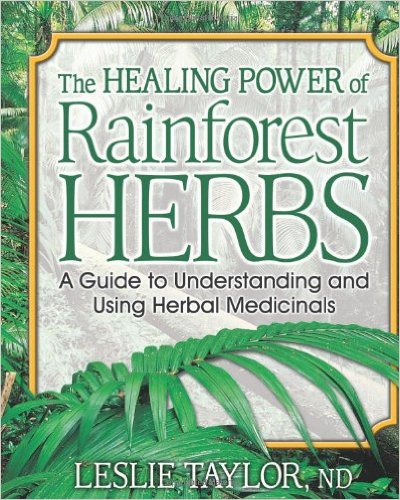
 Extensive information about
Erva Tostao is covered on the Raintree Forest website.
Even better, you can purchase Leslie Taylor's excellent reference book,
The Healing Power
of Rainforest Herbs: A Guide to Understanding and Using Herbal Medicinals at Amazon. Extensive information about
Erva Tostao is covered on the Raintree Forest website.
Even better, you can purchase Leslie Taylor's excellent reference book,
The Healing Power
of Rainforest Herbs: A Guide to Understanding and Using Herbal Medicinals at Amazon.
 A brief description of Erva is provided on
Wikipedia. A brief description of Erva is provided on
Wikipedia.
|





